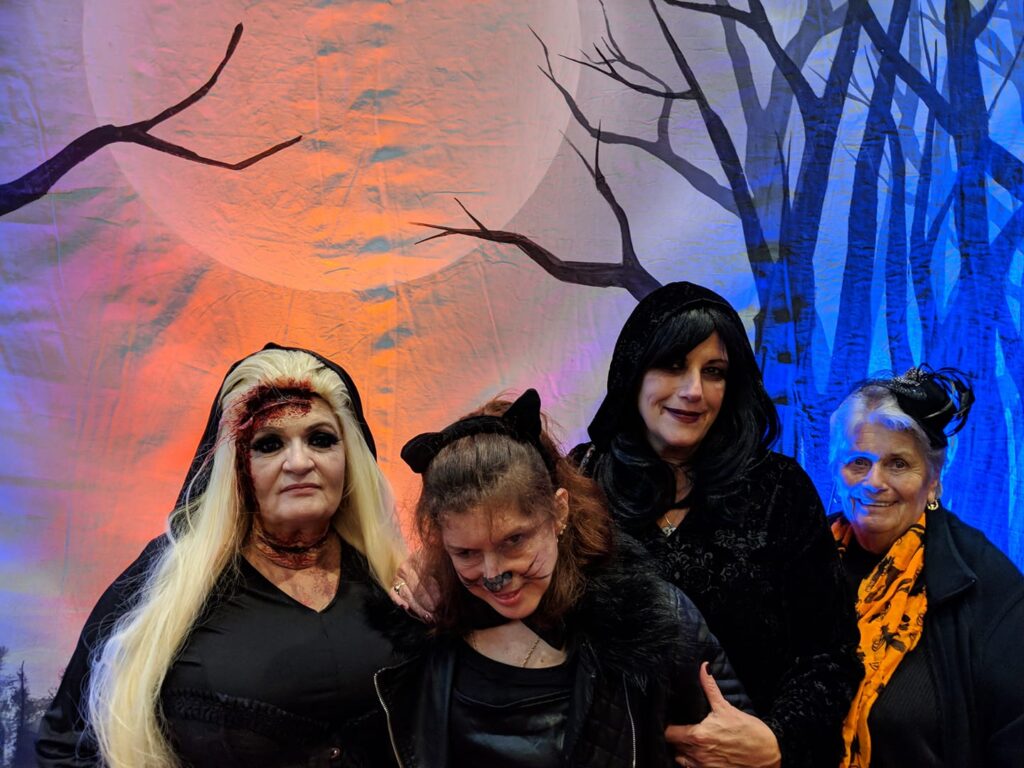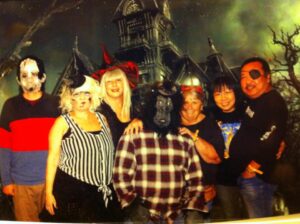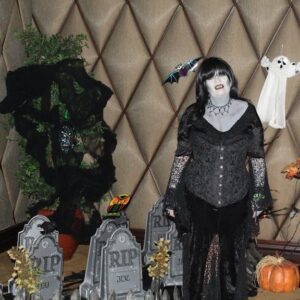Moving to a new country also means being exposed to different holidays and traditions. Simultaneously you might leave some behind that you will really, really miss. So in today’s episode, I will talk about some of my new favorite holidays and traditions here in the US and some that I miss a lot from Sweden.
My Absolute Favorite New Holiday
Let me start by reminding you that I moved from Sweden over 20 years ago, and I know that some of the traditions I love over here nowadays have spread and are embraced in Sweden as well. And with that said, one of those is my absolute favorite holiday tradition here. That is Halloween. When I left Sweden, we didn’t celebrate Halloween, and today that is my top holiday, all holidays included. I love it more than Christmas or Swedish midsummer. Halloween speaks to me like no other holiday. I quickly fell in love with most aspects of Halloween when I moved here. Everything from decorating the house to giving out candy to trick-or-treaters, or maybe most of all, getting dressed up and coming up with makeup and wigs for a costume and going to a Halloween party.
It started quietly with just me having a few pumpkins and Jack O’Llanterns in my house, and of course, giving out candy to kids that came and knocked on the door until today when I have boxes after boxes with costumes and makeup and wigs. I should start planning for my next Halloween costume as soon as we get closer to May or June every year. I am not necessarily into the really gaudy and horror version of Halloween. But I love creating costumes, and I love creating concepts around those costumes. I am lucky because my family usually attends at least one or two Halloween parties yearly, so I can create several costumes. I create costumes for me and my sister-in-law, who is handicapped, which is a challenge in itself because she always wants to be something pretty, so over the years, she and I have been cats, she has been a cute little kitten, and what I have been the cat in the hat. We have done the Little Mermaid where she is, of course, Ariel, and who am I, Ursula. That are just a few examples of costumes that I love to create.
I don’t know what it is about Halloween that really speaks to me. Maybe it is the creativity in coming up with a concept, creating the costumes, and trying out different types of makeup, but it is something I really love. I am sure today, in Sweden, there are these Halloween parties as well, and whether I moved here or had been left in Sweden, I would eventually have found my passion for Halloween.
Other American Holidays I Love
Another holiday I have learned to appreciate, even though we don’t really celebrate it in my family, is one that you can’t avoid if, if you live in the United States, and that is St. Patrick’s Day, the day when they jokingly say on St. Patrick’s Day, everyone is Irish. I know very little about the background of St. Patrick’s Day. I have. that how we celebrate it here in the US is a very American way of celebrating St. Patrick’s Day. They don’t have that the same way in Ireland, but here it is, the day when everything is green, and restaurants have typical Irish food. Many of them even color their beer green on this day. And in Chicago, they even color the whole river green. It’s a very festive day. That is very much about eating good food, enjoying life, and a lot of beer. We usually go out for lunch, eat something typical Irish, wear our green shirts or some Leprechaun shirts, and everybody, wherever you go, is happy and celebrating St. Patrick.
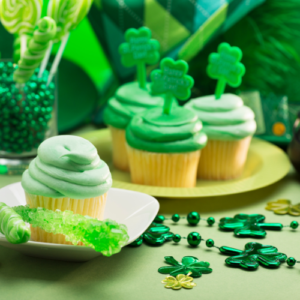
Another important but also very appreciated holiday is, of course, Independence Day or the 4th of July. Historically, this is an important day. It was the day when the USA became an independent state; today, the 4th of July, is the official start of the summer, and everybody is barbecuing. This is a way to start the summer in the company of friends and family over a barbecue, and depending on where you live in the US, it might be the first hot day where you can spend the whole day outside around the barbecue. But just as we have the official start of the summer, we also have the unofficial end of the summer, Labor Day. It is the first Monday of September. It is an official holiday. so many offices, and if you work for the state or a job like that, you usually have this day off, and Labor Day is usually also a lot of barbecuing. Of course, we start and end our summer with barbecuing, but it also had many old traditions that nobody takes seriously anymore, but it used to be said that you can’t wear white after Labor Day. This is the end of the summer. Put away your white shoes and clothes, and the summer is over.
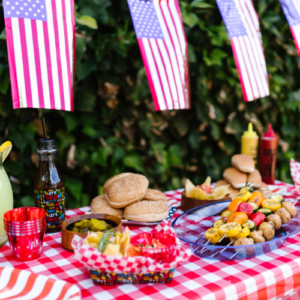
And the last American holiday I want to talk about is actually the first one I experienced here in the US with my American family, and that is, of course, Thanksgiving. And just like with so many other holidays, both here and in Sweden, I guess most of the world holidays are connected to food, and Thanksgiving is very much so. Thanksgiving is the fourth Thursday of November, and you have your Turkey, you have your stuffing, you have all these typical Thanksgiving food for me; this is very much a way to connect with family, and as I said, this was the very first holiday I celebrated with my whole new American family. It is a holiday where you get together, celebrate, and enjoy each other. And maybe even reflect on some things you must be thankful for.
Swedish Holidays I Miss
But of course, there are also holidays that I truly miss from Sweden, and the one I miss the most is probably the Swedish mid-summer. This is the Friday of the week of June 19 to 25. Somewhere in that week, depending on what day the Friday falls on, is Midsummer, Midsommar as we say in Sweden.
This is also a celebration that summer is coming. It is to break away from the dark winter. It is also around the time of the longest day of the year. It’s not always on the actual mid-summer since mid-summer is floating in the dates, depending on when the Fridays are, but in Sweden, if you are far up in the north, this is when you can see the midnight sun. It is also very much family oriented. In most places, you have a Midsummer dance. You have a maypole decorated with greenage and raised flowers, and you dance around the midsummer pole. You usually have some picnic or maybe even a mid-summer dinner like a smorgasbord, where you eat herring fresh potatoes, you drink schnapps, you sing your schnapps visa, and when you are at the midsummer pole, you have the very famous dance round the pole where the Swedes, young, old, sober, jump around the pole like little frogs This is something that I miss a lot. It’s not a tradition that is easy to introduce here because I can’t build a Midsummer pole alone. I can’t find all the foods we usually eat; it’s a festivity that takes a lot of people. It takes a village to create your mid-summer festivity.

As I said, mid-summer is a lot about celebrating that summer is here, but even before that, we have a tradition that I also miss: Walpuris Night. This is on April 30th, and what we celebrate on that night is the welcoming of spring. We have this long, dark winter. So after that, we have two holidays which we celebrate. First, that spring is coming, and then that summer is coming. Walpuris night is usually you have a huge bonfire. We have a lot of choirs that come out and sing. And people gather around this huge bonfire. They sing songs about beautiful may welcome, and Spring is here, and it’s all about enjoying the light coming back to a dark Sweden.

And the third one I want to talk about, which I miss a lot, especially since I worked as a teacher back in Sweden, is December 13th, when we celebrate Santa Lucia. This is in the darkest time of the year; once again, light is important for this holiday. Lucia was originally an Italian saint, and I am unsure how this tradition became so Swedish. Still, every preschool, school, workplace, retirement home, and community has its own Lucia. When it comes to the municipal, Lucia, it’s usually an election between several candidates, and someone wins, almost like a pageant. Still, in every school, I have ever worked at, we have a Lucia train, as we call it. It consists of one girl, Lucia, with a crown with candles in her hair. She is followed by her tärnor, as they are called. They all have long white robes, and Lucia has these candles in her hair and a red ribbon around her waist while her tärnor, her maids, also have these long white cloaks, but they have glitter garlands around their waist and, in their hair, and they are carrying candles in their hands. We also have the star boys’ wearing long white cloaks again, but they have tall pointy hats with stars on them, and they are walking in the procession singing songs. Traditionally they used to, if they are at, for example, at an office, bring coffee and the typical saffron bun or something like that. But as I said, this is a very special tradition that I miss a lot.
I was lucky when I lived up in New Jersey that in Philadelphia, they have a Swedish church that had this Saint Lucia celebration every year, so I was fortunate to bring my American family there at one point. So I have shown them.
Here are a few links to YouTube videos to see what Lucia is about.
Different traditions
Before I end, today I will mention a couple of things about holidays that we celebrate in Sweden and the US, but where we have some different traditions and the biggest of them. Is Christmas. Of course, you might know that in Sweden, we celebrate Christmas on Christmas Eve, the 24th. While over here, the bigger day is the 25th of Christmas; we also have different food traditions. We usually see Turkey on the Christmas table, while in Sweden, we have a very specific Christmas ham, a non-smoked salt-cured ham that I have managed to order a couple of times over here and make for my family for Christmas. But for a lot of the other food that is typically Swedish, I can’t get a hold of what I do get ahold of every year, and that has become a new tradition for my family that we must have when it’s Christmas is glögg, it’s hot wine with specific spices in it. You warm it up and serve it with raisins and almonds; nowadays, it isn’t a complete Christmas in our Swedish American family without having glögg on the Christmas table.
Another funny thing that is very typical Swedish that I don’t miss, but I want to share with you is that everything stops on Christmas Eve on the 24th at 3:00 PM in Sweden. There is one important question all Swedes must decide; Should we do our Christmas gifts before or after three o’clock? Because what happens at three o’clock and that stops all activities in Sweden? It is an hour-long show on TV with Donald Duck and his friends. This has been a tradition in Sweden since 1956, don’t quote me on that. I might have the wrong year, but I have always watched Donald Duck and his friends as long as I have lived.

We also have some differences in celebrating Easter again in Sweden; the big day to celebrate on Saturday. Here in the US, the big celebration is on Sunday. Another big difference is that Friday, Saturday, Sunday, and Monday are official holidays in Sweden. While over here, it’s only Sunday. The Friday before, uh, Easter in Sweden is called Long Friday, and it, when I was a kid, it was very long. Day, everything was closed. Nothing happened. It was a long, long day. It is called Good Friday, but from what I have heard from my family, it used to be a very long day here.
Two, A tradition that’s very common here is that you have. Easter Bunny. He doesn’t show up in Sweden. Easter is about chickens in Sweden, and we don’t have the Easter Ban Bunny. The way you have over here, what we have on the Thursday before Easter is that we have witches. These are kids dressing up as old men and women with a shawl over their heads. They paint their cheeks red with freckles, go from door to door, and they usually draw some little Easter cards they hand out to people in exchange for candy. And this, for me growing up, is probably the closest we have in Sweden to your trick-and-treat for Halloween. I believe that I have an episode on my podcast about Easter.
I believe I have done one episode. About mid-summer, and I am sure I have done one about Christmas. So if you are curious and want to learn more about any of these, look at my older episode, and you will find them there. This is where I will end today’s episode. I hope you enjoyed it and maybe you even learned something about the differences in holidays and traditions.
Until next time, as we say in Sweden, Hej Då!


